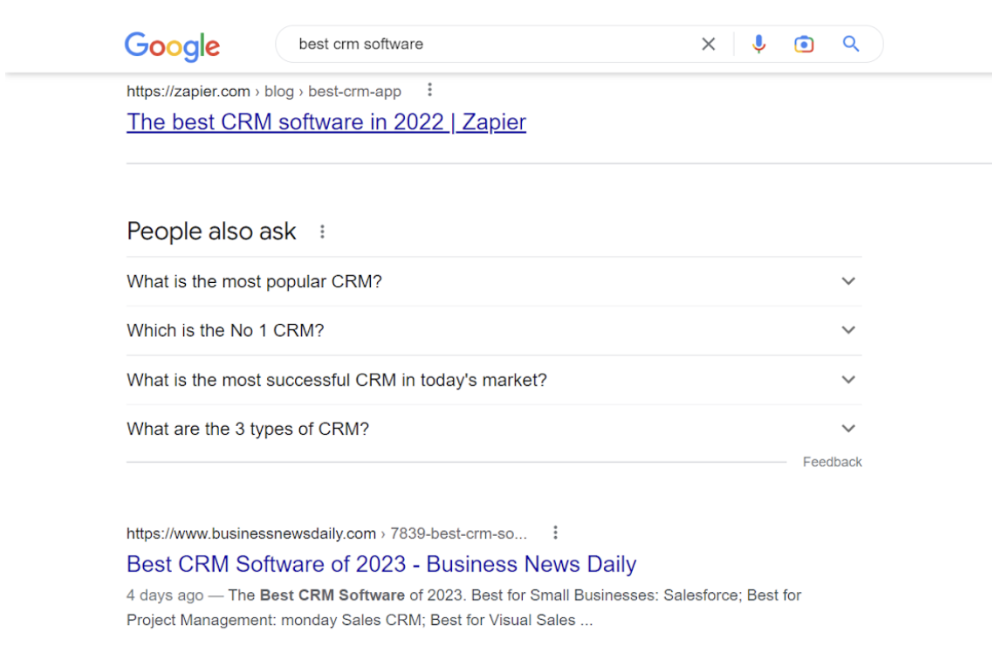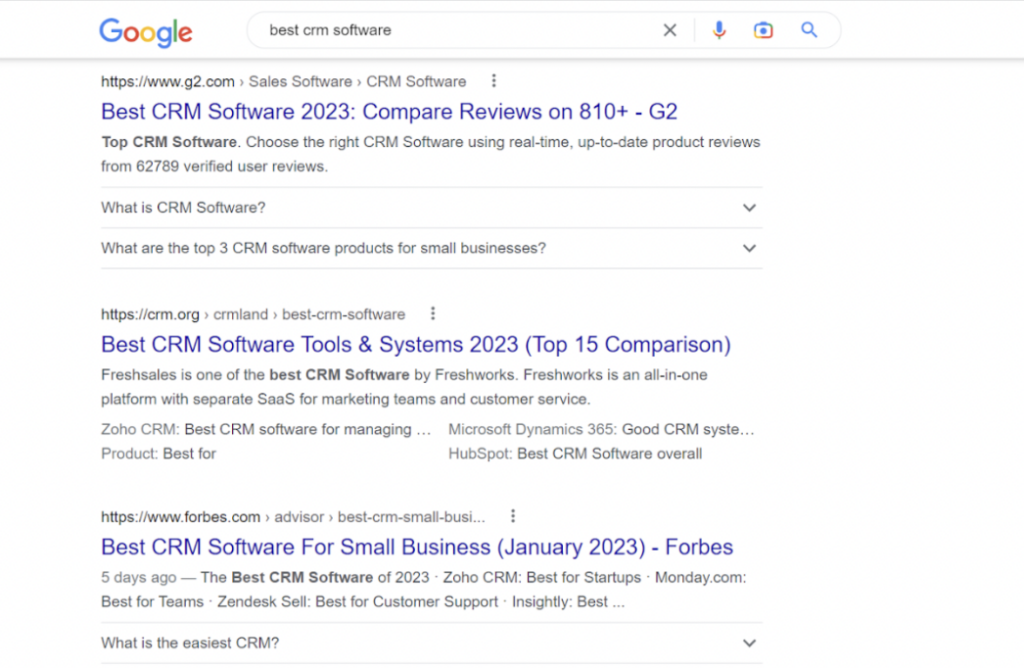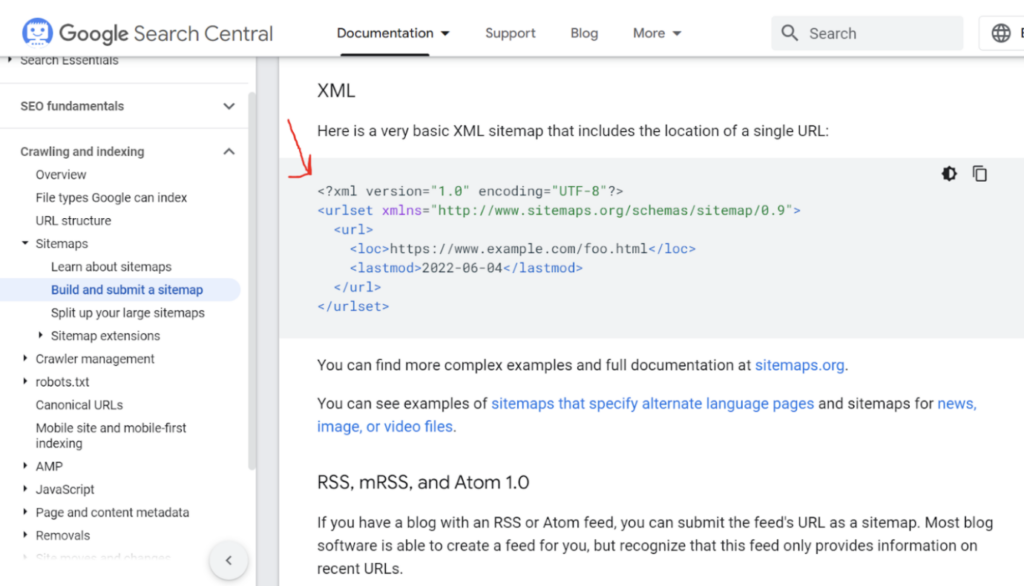Let’s start with a quick exercise.
Open a new page on your internet browser.
Click on the search box and type “best CRM software.”
If you use Google, you see a search result similar to the screenshots below:


Did you notice all the articles on the first page have the year in the title?
Why? Recently, Joe Pulizzi asked a question on Facebook that triggered a clear split in opinion from different individuals. He asked, “should marketers date-stamp their content?” It was interesting to read different opinions in the comment session. Some said they ignored articles that don’t have the date in the title. However, others defended their point that removing the date from an article increases its traffic. So, who is right?
What does this mean for evergreen content?
Why do roundup listicles have the year in their titles?
Do search engines favor software comparison pages with the year in their titles?
Enough with the questions! Read on as we lead you to the answers to these questions.
But first, let’s understand Google’s perspective on adding dates to title tags.
Google’s Concept on SEO Impact of Dates in Title Tags:
In a recent Google Search Central SEO office-hours hangout, Google’s search advocate, John Mueller, addresses if including the publication dates in title tags is good for SEO.
John says, “If you want to. I don’t think it changes anything. For news articles, I think it makes sense to include the date in various places on the page, which can include the title. Just because with news articles, we try to understand the page’s primary date. And we do that by looking at all the mentions and things you have on the page. And we can confirm that date with these mentions on the page, then it’s easier for us to pick that up, but I think for a constantly changing page, like currency prices, as you mentioned… I don’t think it’s critical to have the date in the title.”
Watch the full video to find out,
The Advantages and Problems of Dates on Software Comparison Pages
Beyond content updates, adding dates to title tags can be a crucial strategy to gain traction on result pages.
For example, if a search engine user searches for the latest CRM software update. Such users will gravitate toward the latest results. And date can be a vital factor in vetting an article’s freshness.
Besides, a date is crucial for helping searchers evaluate the information’s context and sort through the vast amount of content on the internet to locate the most pertinent facts and up-to-date statistics.
When an article’s date indicates that it was written recently—within the past few weeks—it signals to them that it is current or recent, and when the date is far in the past—it signals to them that the article may be out of date. This shows that date updates can increase click-through-rates.
On the contrary, a date can distract your reader when you have content that is “timeless,” meaning it doesn’t date because the advice you give or the ideas you discuss always apply. When they go to the post and notice that it was written in 2010, a small alarm goes off in their heads to let them know that what they are reading is not “recent.”
Also, the knowledge that companies update their software with new features can send a wrong signal to a reader reading a software comparison page dated 2010 this year.
No matter what your content includes, if a reader has this reaction, it will appear “old” to them, and you will lose their interest. Although not every one of your readers may experience this, over time, it adds up.
So, a date can positively and negatively impact an article.
Will Changing Article Date Affect SEO Rankings?
There are two types of date updates:
– Changing the publishing date on the page
– Changing the date in the sitemap
In a conversational tweet between Lily Ray and John Mueller, Lily asked, “CMS platforms that automatically update the “Date Modified” when somebody made a change to the page (i.e., adding a comma), could this present quality issues if done at scale?”
John replied, “I don’t think you’d add commas at scale. I wouldn’t worry about it for individual pages, even if you have many things you update regularly.”
Here is the key takeaway, significant date updates for individual pages won’t affect your SEO rankings. However, date change can be hazardous when you change the date in the sitemap.
Google’s standard on a sitemap is that a page’s <lastmod> must be registered accurately. If not, Google robots won’t be able to read the new data. Google crawlers pay attention to the <lastmod> parameters.
Ensure the date format follows the W3C Datetime standard:
The URL is read by robots precisely as it appears in the sitemap. The absence of HTTPS, www, or other address-related structural components is unacceptable. Also, it would help if you didn’t sort URLs according to modification date, alphabet, or any other rule. Robots care more about updates than data sequencing.
According to Google Search Central, “All formats limit a single sitemap to 50MB (uncompressed) or 50,000 URLs. You will have to break your list into multiple sitemaps if you have a larger file or more URLs. You can optionally create a sitemap index file (a file that points to a list of sitemaps) and submit that single index file to Google. You can submit multiple sitemaps and/or sitemap index files to Google.”
Lastly, Glenn Gade’s recommendation for the date update date is to show the two dates – the original publication date and the date the post was updated. Also, he mentioned that you could use the “datepublished” and “datemodified” schema to make it easy for Google to recognize.
When Should You Change The Article Date?
Google’s developer advocate, Martin Splitt, mentioned during the sixth edition of SEO myth-busting season 2 that it would be best to update old content rather than create a new one with very similar content. Search engines love fresh and relevant content. However, changing your article date isn’t proof that your article is new and will rank better on search engines.
In a recent interview with Search Engine Journal, John Mueller said, “changing publishing dates on web pages will not improve search rankings if no significant changes were made to the content.” He continued, “While updating the date is a good sign that the content is fresh, Google’s algorithm doesn’t work that way. Shuffling some images and content around without adding new information and then changing the date will impact your user experience and mislead your visitors into thinking that something is new. They won’t return to your page when they find the truth.”
For evergreen purposes, change the date on an article’s title tag after you’ve made a quantifiable improvement on the article.
Final Words
Here is the key takeaway: adding dates in title tags doesn’t positively or negatively impact the article’s ranking on search engine result pages. However, if it will benefit your users and drive more interaction, add it.
The best thing to do is track and monitor your article in the SERPs so you can act when things go wrong. Keyword.com is an accurate SEO rank tracking and position tracker that monitors keyword activities on result pages and provides insights to outsmart your competitors. In addition, this tool features a SERP tracking API that allows you to assess your site’s SERP performance and track thousands of keywords without getting drowned in data. Try it out for free!
